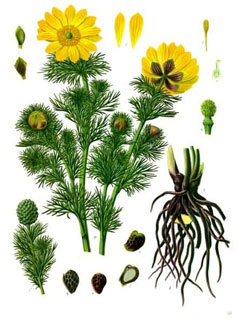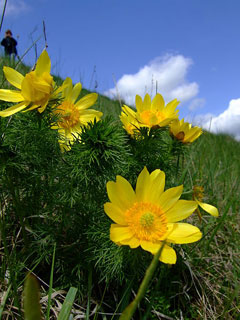 |
|
|
 |
| http://commons.wikimedia.org/wiki/User:Vindicator |
Translate this page:
Summary
Physical Characteristics

 Adonis vernalis is a PERENNIAL growing to 0.3 m (1ft) by 0.3 m (1ft in).
Adonis vernalis is a PERENNIAL growing to 0.3 m (1ft) by 0.3 m (1ft in).
See above for USDA hardiness. It is hardy to UK zone 3. It is in flower in March, and the seeds ripen from May to June. The species is hermaphrodite (has both male and female organs) and is pollinated by Bees, flies, beetles. The plant is self-fertile.
Suitable for: light (sandy), medium (loamy) and heavy (clay) soils and prefers well-drained soil. Suitable pH: mildly acid, neutral and basic (mildly alkaline) soils. It can grow in semi-shade (light woodland) or no shade. It prefers dry or moist soil.
UK Hardiness Map
US Hardiness Map
Synonyms
Plant Habitats
Cultivated Beds;
Edible Uses
References More on Edible Uses
Medicinal Uses
Plants For A Future can not take any responsibility for any adverse effects from the use of plants. Always seek advice from a professional before using a plant medicinally.
Antianxiety Antiarrhythmic Cardiotonic Diuretic Sedative Vasoconstrictor
Medicinal Parts: Roots and whole plant[301]. Pheasant's eye has a long history of medicinal use and is still retained in the Pharmacopoeias of several European countries[268]. The plant contains cardiac glycosides similar to those found in the foxglove (Digitalis purpurea)[254]. These substances improve the heart's efficiency, increasing its output at the same time as slowing its rate[254]. It also has a sedative action and so is generally prescribed for patients whose hearts are beating too fast or irregularly[254]. The herb is not often prescribed, however, due to irregular absorption[268]. The herb is cardiotonic, diuretic, sedative and vasoconstrictor[4, 7, 9, 13, 46, 238]. It has sometimes been used internally as a cardiotonic with success where the better known foxglove (Digitalis purpurea) has failed - especially where there is also kidney disease[4]. The herb is also used in the treatment of low blood pressure and its strong diuretic action can be used to counter water retention[254]. It is included in many proprietary medicines, especially since its effects are not cumulative[238]. The plants are harvested every third year as they come into flower[7], they are dried for use in tinctures and liquid extracts[238]. The herb does not store well so stocks should be replaced every year[238]. Use with great caution[9], see the notes above on toxicity. The plant is used in homeopathy as a treatment for angina[254]. The German Commission E Monographs, a therapeutic guide to herbal medicine approve Adonis vernalis for arrhythmia, and nervous heart complaints (see [302] for critics of commission E)
References More on Medicinal Uses
The Bookshop: Edible Plant Books
Our Latest books on Perennial Plants For Food Forests and Permaculture Gardens in paperback or digital formats.

Edible Tropical Plants
Food Forest Plants for Hotter Conditions: 250+ Plants For Tropical Food Forests & Permaculture Gardens.
More

Edible Temperate Plants
Plants for Your Food Forest: 500 Plants for Temperate Food Forests & Permaculture Gardens.
More

More Books
PFAF have eight books available in paperback and digital formats. Browse the shop for more information.
Shop Now
Other Uses
References More on Other Uses
Cultivation details
Grows well in any ordinary garden soil that is not too heavy[1]. Prefers a moist well-drained soil in sun or semi-shade[4, 200]. Easily grown in a very well-drained rather dry soil in sun or part shade[187]. Plants flower better when growing in a sunny position[268]. This plant is adored by slugs and is therefore very difficult to grow in the open garden where slugs are common[187]. A very ornamental plant[1], it is rather rare in the wild so only cultivated plants should be harvested[7]. A greedy plant inhibiting the growth of nearby plants, especially legumes[54].
References Carbon Farming Information and Carbon Sequestration Information
Temperature Converter
Type a value in the Celsius field to convert the value to Fahrenheit:
Fahrenheit:
The PFAF Bookshop
Plants For A Future have a number of books available in paperback and digital form. Book titles include Edible Plants, Edible Perennials, Edible Trees,Edible Shrubs, Woodland Gardening, and Temperate Food Forest Plants. Our new book is Food Forest Plants For Hotter Conditions (Tropical and Sub-Tropical).
Shop Now
Plant Propagation
Seed - best sown in a cold frame as soon as it is ripe or else it can be slow and erratic to germinate[200, 238]. Sow the seed in partial shade in rich soil in September or March[111]. Prick out the seedlings when they are large enough to handle and grow them on in the cold frame for their first season. Plant out when dormant in the autumn[K]. Division in early spring or in autumn. The divisions can be difficult to establish[200], so it is probably best to pot them up and keep them in a cold frame or greenhouse until they are growing away well.
Other Names
If available other names are mentioned here
Native Range
TEMPERATE ASIA: Russian Federation-Ciscaucasia (Ciscaucasia), Russian Federation-Western Siberia (Western Siberia), Russian Federation-Eastern Siberia (Eastern Siberia (southwest)) EUROPE: Sweden (southeast), Austria, Switzerland, Czech Republic, Germany, Hungary, Poland, Slovakia, Russian Federation-European part (European part (south)), Ukraine (incl. Krym), Bulgaria, Croatia, Italy (north), North Macedonia, Romania, Serbia, Spain, France
Weed Potential
Right plant wrong place. We are currently updating this section.
Please note that a plant may be invasive in one area but may not in your area so it's worth checking.
Conservation Status
IUCN Red List of Threatened Plants Status :

Growth: S = slow M = medium F = fast. Soil: L = light (sandy) M = medium H = heavy (clay). pH: A = acid N = neutral B = basic (alkaline). Shade: F = full shade S = semi-shade N = no shade. Moisture: D = dry M = Moist We = wet Wa = water.
Now available:
Food Forest Plants for Mediterranean Conditions
350+ Perennial Plants For Mediterranean and Drier Food Forests and Permaculture Gardens.
[Paperback and eBook]
This is the third in Plants For A Future's series of plant guides for food forests tailored to
specific climate zones. Following volumes on temperate and tropical ecosystems, this book focuses
on species suited to Mediterranean conditions—regions with hot, dry summers and cool, wet winters,
often facing the added challenge of climate change.
Read More
Expert comment
Author
L.
Botanical References
200
Links / References
For a list of references used on this page please go here
Readers comment